
Tapped: Season 3 Episode 10

Water scarcity, pollution and flooding issues in Ambos Nogales have been exacerbated by climate change and unchecked urbanization in Nogales, Sonora, which the Mexican border city is working to rectify in innovative ways, including creating an environmental police force, dedicated urban forests, a climate change fund, investing in a new water treatment plant and passing on the knowledge and skills on to the next generation.

Transcript
Zac Ziegler: Arroyos and creeks crisscross Ambos Nogales — the collective name for the two Nogales cities on either side of the border.
The population of Nogales, Sonora, has grown by at least 20% in the last decade and with it the number of roofs, parking lots, streets and other surfaces that are impervious to water.
Danyelle Khmara: They cover former streams and waterways and alter the water cycle. They pollute that naturally-occurring water and bring yearly flooding, leading to accidents and even death — including deaths of children.
(Music fades in)
ZZ: This is Tapped . I'm Zac Ziegler
DK: And I'm Danyelle Khmara.
ZZ: So how do you take a place that has made its ground a one-way street for water, only allowing it to be pumped up from the aquifer it sits atop, and make it so that water can again travel downward through the soil?
Danyelle's got it from here.
(Music fades out)
(Sound of Kids at the school)
DK: I’m at the middle school José Eduardo Curlango Limón in Nogales, Sonora. The school is in Colonia Héroes, one of Nogales’ oldest neighborhoods.
I’m meeting up with biology teacher Gloria Camacho to talk about a project her students did earlier this year, where they learned how to build green infrastructure and to play a role in solving the region’s long-standing water issues.
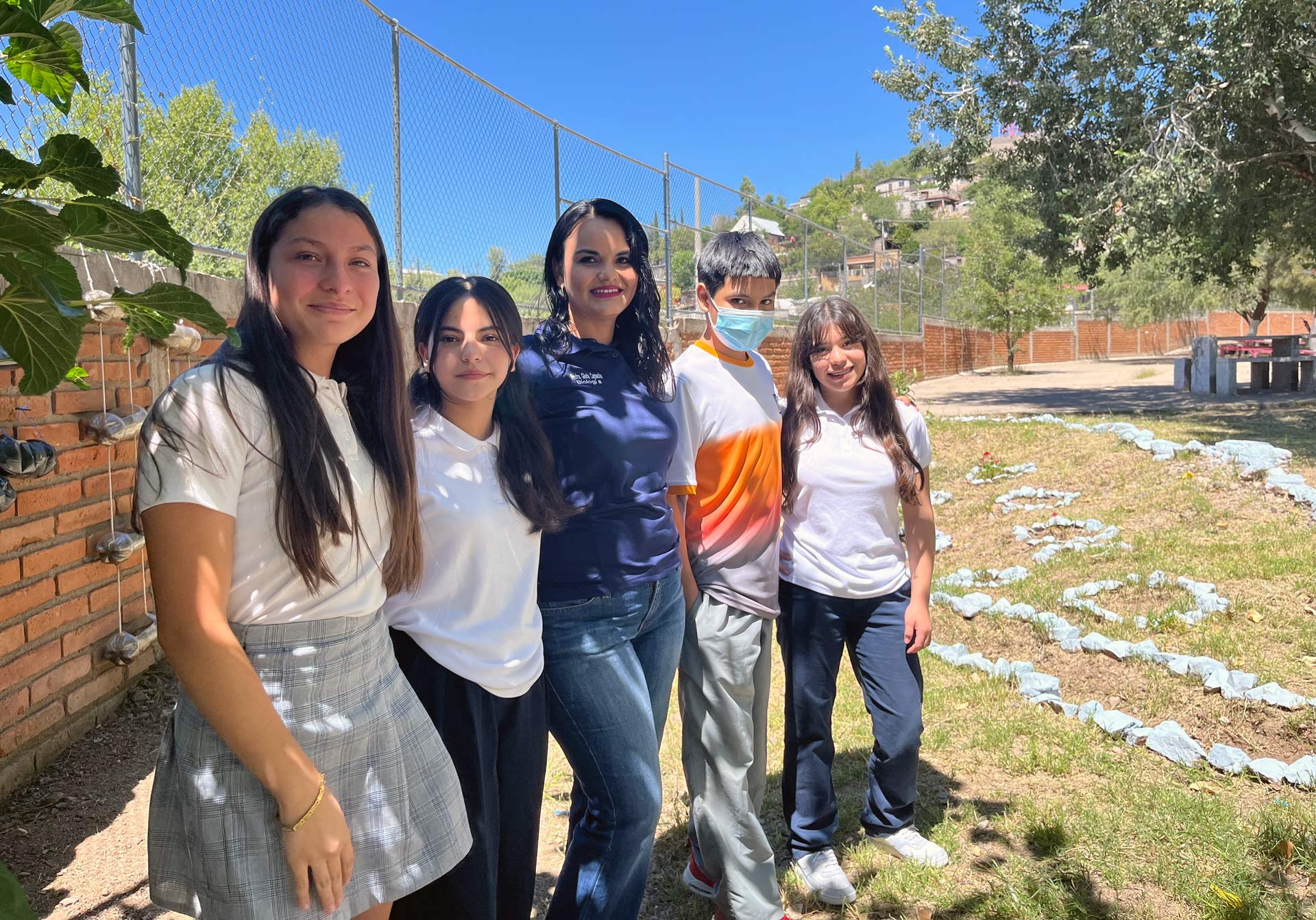 Middle school students Guadalupe Silvain Velazquez, Suheimy Ballesteros, Francisco Ivan Arbayo Rojas and Ivanna Moreno Quezada with biology teacher Gloria Camacho at their school José Eduardo Curlango Limón in Nogales, Sonora.
Middle school students Guadalupe Silvain Velazquez, Suheimy Ballesteros, Francisco Ivan Arbayo Rojas and Ivanna Moreno Quezada with biology teacher Gloria Camacho at their school José Eduardo Curlango Limón in Nogales, Sonora.(Field audio)
Gloria Camacho: Ya fuiste a ver el jardin?
DK: No, no fui todavía. ¿Me lo puedes mostrar?
GC: Si… (Fades out)
DK: She takes me to see the rain garden the children built.
(Music fades in)
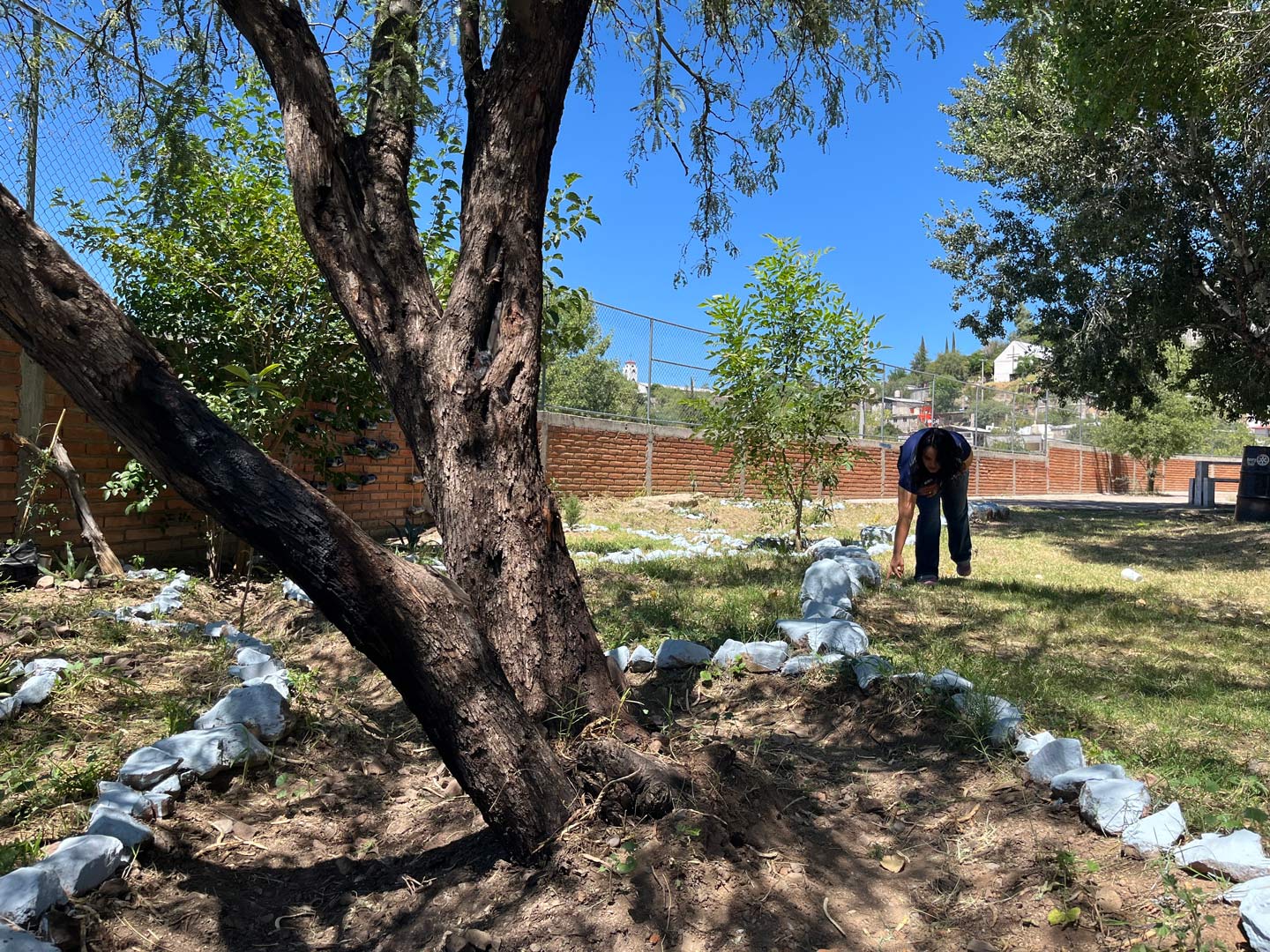 The students of José Eduardo Curlango Limón in Nogales, Sonora, built a rain garden and in the process learned how to play an important role in harvesting water and helping return it to the aquifer.
The students of José Eduardo Curlango Limón in Nogales, Sonora, built a rain garden and in the process learned how to play an important role in harvesting water and helping return it to the aquifer. DK: Despite being on a hill, the school experiences seasonal flooding problems. Roofs and nearly entirely paved grounds produce nearly 960 cubic meters of runoff annually.
That’s about the size of ten 40-foot shipping containers flooding the school's south grounds every year. This runoff also flows into the surrounding streets, carrying trash, causing erosion and flooding areas downstream.
On the southern side of the school is a patch of dirt, slightly larger than a typical two-car garage, with newly planted trees, a few flower bushes, and gray rocks that create little circles around the new plants and line the fresh irrigation ditches. Along the brick wall behind it, black plastic soda bottles hang on their sides, with the side facing up cut open to create little planters.
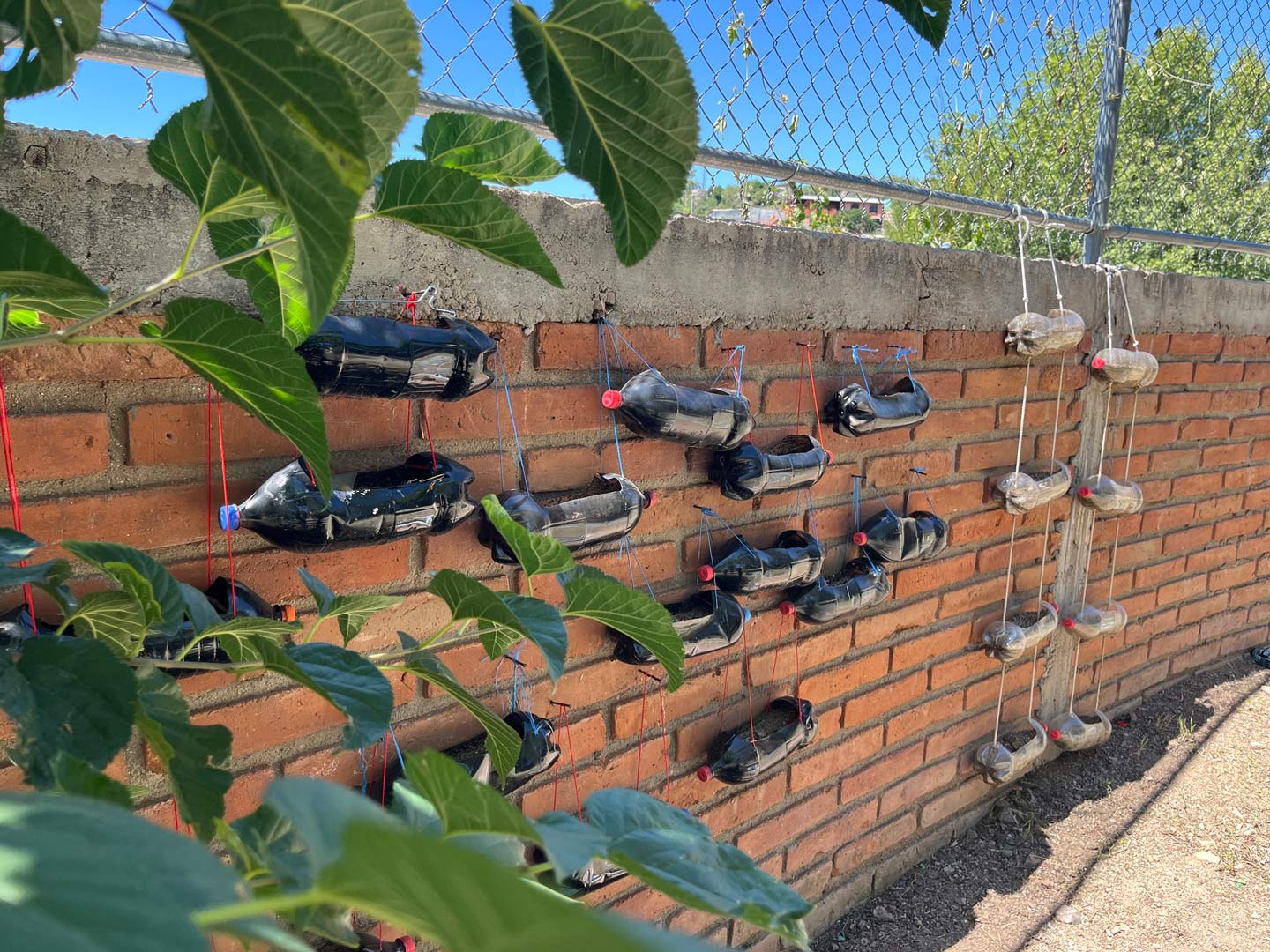
(Field audio)
CG: Las plantitas, la mayoría, aún todavía mantenido bien porque ha estado lloviendo constantemente.
DK: Se ve bien.
CG: Salvo este de aquí que se secó. Pero pues, si se ve bien.
DK: ¿Y cuáles árboles plantaron?
(Field audio fades)
DK: The garden is part of a project, led by Arizona State University's School of Transborder Studies and El Colegio de la Frontera Norte, to construct rain gardens and build water resiliency and equity for the children of Ambos Nogales. The project is in its infancy. And is one piece of the puzzle to solving a much larger problem.
Professora Camacho says because of this, many of the children started the project with a negative experience of the rain.
GC: Unas de las actividades que realizamos en el taller con los alumnos era elaborar un dibujo y se llamaba “Yo y la lluvia”.
DK: She says that one of the first activities they did as part of the project was to have the students make a drawing called “Me and the rain.”
The children were asked to make a drawing that captures how they feel when it rains or experiences they’ve had with the rain. Hilda García Pérez, with El Colegio de la Frontera Norte in Nogales — who I’ll introduce in a bit, showed Profesora Camacho what students in Nogales, Arizona, had done with the project.
GC: Y ellos muy felices en la lluvia, con sus impermeables, osea, viendo la lluvia de forma positiva, algo bonito. Y los estudiantes de Nogales, Sonora, dibujaron arroyos, carros que se lo llevaba la corriente, deslaves de los cerros, y todo el fluido, el movimiento de agua que ellos dibujaban era así, horizontal. Arrastres deslaves, incluso un niño dibujó perritos que se los llevaba el agua.
DK: The drawings the Arizona students made showed them happy in the rain, with their raincoats. They saw the rain in a positive way, as something nice. While the students from Nogales, Sonora, drew cars being carried away by the current, landslides coming down hills, and all the movement of water that they drew was horizontal. One child even drew dogs being carried away by the water. One child made a drawing with a bunch of dead chicks — baby chickens — and said it was a drawing of the rain drowning his pollitos.
GC: … y un niño hizo un dibujo con muchos pollitos muertos, y le digo, “Qué es esto?” “Es que con la lluvia se ahogaron mis pollitos,’ dijo. Que eso los había llevado la lluvia. (Fades out)
(Music)
DK: 14-year-old student Guadalupe Silvain Velazquez helped build the rain garden in her school.
Guadalupe Silvain Velazquez: Pues, no he estado afuera de mi casa cuando hay lluvias muy fuertes pero si hay muchas, si hay veces que si se inunda muy feo. Y aquí, el jardín de lluvia nos puede ayudar a recaudar el agua para que no este más asi.
DK: She says she hasn’t been caught out in a heavy rain, but it’s common that the rains cause bad flooding. And the rain gardens they made can help them collect water so that no longer happens.
(Music)
 Rain garden built at Secundaria General # 3 Humberto Campos Varela, in Nogales, Sonora.
Rain garden built at Secundaria General # 3 Humberto Campos Varela, in Nogales, Sonora.
As promised, Hilda García Pérez — a researcher who worked closely on the project.
Hilda García Pérez: Fue para nosotros muy interesante observar cómo dos comunidades que comparten, digamos, la misma ecología que están solamente divididos por un cerco, los niños perciben la lluvia de manera distinta.
DK: It was interesting for those involved in the project to observe two communities that share the same ecology, which are just divided by a fence, but the children see rain in two distinct ways. …
HG: … en Nogales, Arizona, la lluvia cae del cielo, digamos, es vertical. Y en México, la lluvia es horizontal.
DK: People say that in Nogales, Arizona, the rain is vertical while in Nogales, Sonora, the rain is horizontal.
Hilda says of course it’s the same storms affecting the sister cities, but in Nogales, Sonora…
HG: … en Nogales, Sonora, el efecto de la urbanización en el cual muchos arroyos han sido pavimentados. Hay muchísimo, digamos, invasión de espacios que antes eran arroyos o que eran arroyuelos y todo esto. Generado por los procesos de urbanización ha generado que las inundaciones se han, cada verano allá, incluso muertes — muy, muy desastrosas.
DK: Hilda says that in Nogales, Sonora, many streams and smaller waterways have been paved over — an effect of urbanization. This has led to yearly flooding every summer. Flooding that is often disastrous and deadly.
HG: Es un problema serio del urbanización. De cómo se planeó la cuidad o no se planeó. Entonces tenemos ese problema. Mira, mismas lluvias, y los jóvenes perciben el fenómeno de manera distinta. Pero además lo viven de manera distinta.
DK: Hilda says the problem of urbanization is a serious one. It comes from how the city was planned and what was not planned. There are the same rains on both sides of the border but the children don’t just see it differently, they live it differently.
In building these rain gardens, the kids are building green infrastructure, which is essentially creating green space amongst pavement where water can return to the aquifer.
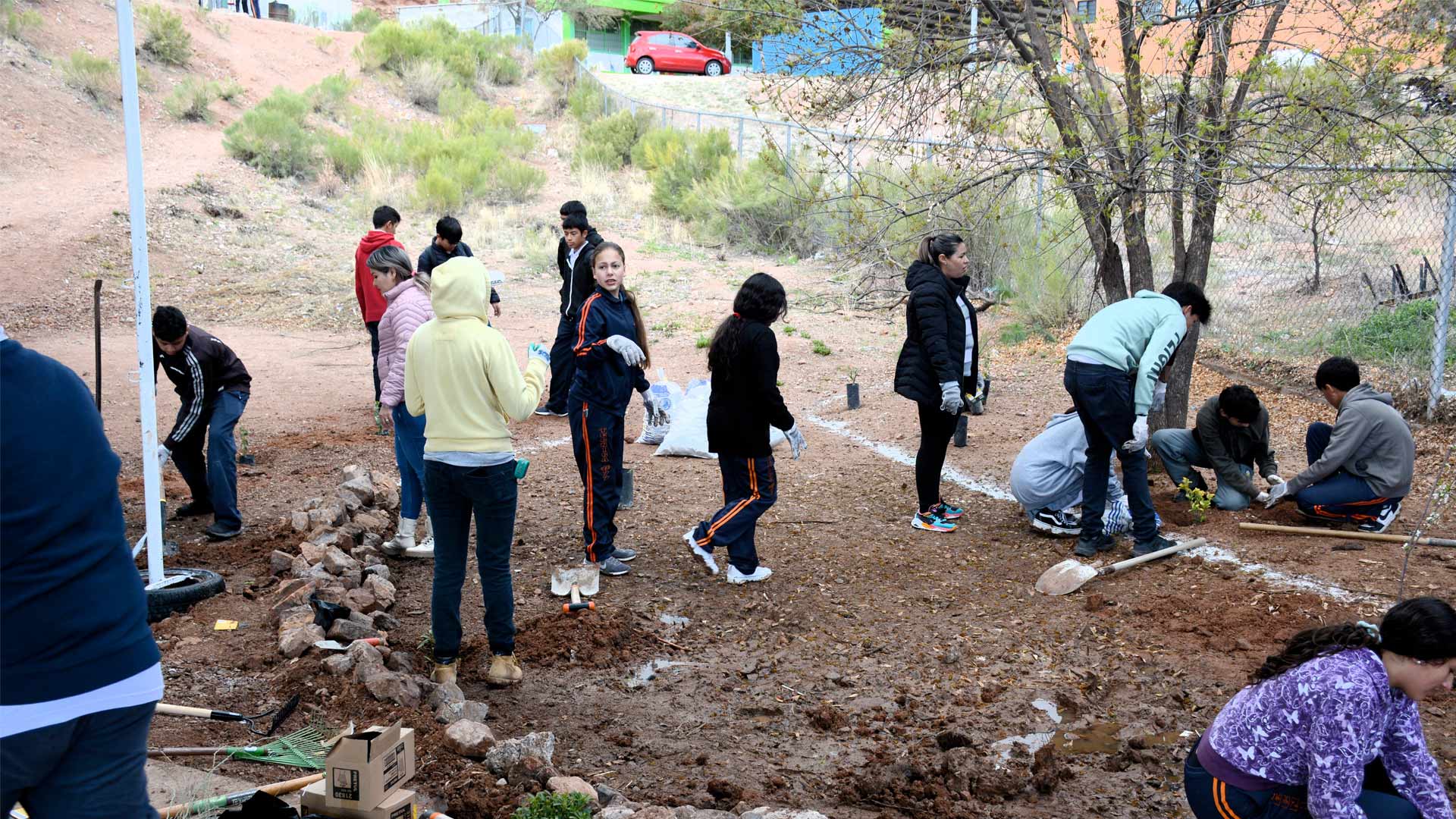
Hilda says this project began as part of a proposal to identify intervention points for green infrastructure. Researchers identified intervention points in both Nogales, Arizona, and Nogales, Sonora, to bring nature back to the cities and places where green infrastructure would help capture water, using nature itself, and contribute to improving the water cycle in the area.
While the flooding is more likely to turn deadly on the southern side of the border, flooding is a serious issue on the Arizona side as well.
Researchers from ASU and other institutions developed a master plan that identified 103 sites for green infrastructure projects on both sides of the border that could help mitigate the impacts of stormwater on the population and the environment.
The project was led by Francisco Lara, a professor at the School of Transborder Studies at Arizona State University.
Francisco Lara: The concept that we are pursuing is a binational network of green infrastructure for Ambos Nogales. Basically what we are trying to do is to identify nodes and the corridors that will create this network of nature based solutions to water issues and flooding issues in the Nogales, Sonora/Nogales, Arizona, area, that will connect, explicitly, the ecology and hydrology of the place. Because they are a part of the same watershed, and every summer, the monsoon reminds us that they are part of the same watershed. Water runs from Nogales, Sonora, into Nogales, Arizona, and creates a lot of challenges for the city and the residents of both sides, on both sides of the border.
DK: Most of the sites they identified — 86 of them — are on the Mexican side of the border, which is the larger city. But the sites in Nogales, Arizona, are larger as there is less urbanization and more open, vacant space in between the built up environment.
FL: In this case, we were also concerned about issues of environmental justice, social equity, in regard to the location of the sites, because one problem that Nogales, Sonora, and Nogales, Arizona, have in common is the lack of green spaces for the local community.
DK: He says one of the criteria used in choosing the 103 sites was places that lack green space, such as neighborhood parks and trees. In that way, building green infrastructure is addressing multiple needs at the same time.
FL: Why don't we incorporate explicitly the idea of bringing green space to communities that lack that space?
DK: He says the school project is an individual, small scale intervention. But there needs to be governance that supports using these types of technologies and solutions to solve the critical water issues and weather uncertainty that Ambos Nogales is facing right now.
They would like to see these projects incorporated in businesses. For example in the case of Nogales Sonora, there are more than 100 maquiladoras that have large buildings and parking lots. Fransisco says governments at all levels need to create mechanisms and regulations and encourage the utilization of green infrastructure and these types of solutions.
FL: Many of the things that we have seen in Nogales right now are directly related to climate change. So these things are going to get worse in the future, and the cities really need to start working hard and figuring out the way to address in a more sustainable way the problems that they're facing right now. And that includes working with the industry, for example, working bi-nationally, for example, to find more robust solutions for the problems that the city has.
DK: And for all the water issues urbanization has created, Nogales, Sonora, has been working hard to address the problems they're facing.
Javier Villanueva is the Urban Planning director for Nogales, Sonora. He says with the Earth close to warming 1-and-a-half degrees in the next five years, Sonora is especially vulnerable. An increase of 1° Celsius could cause serious alterations in the availability of water in the region.
He says that as the population in Nogales, Sonora, has quickly grown and the region has warmed, …
JV: Alguno de los impactos que ha tenido Nogales que ha sido crecimiento poblacional, el incremento de temperatura y también, como un indicador, los pozos — ¿cómo están los pozos? Son en 2021, 88 pozos al veinte por ciento capacidad, nada más. Y 18 pozos a 30 por ciento.
DK: They began to notice a change in local wells. In 2021, 88 wells were at 20% capacity, and 18 were at 30%. It was something they hadn’t seen before, and it had them worried.
JV: ...es algo que no se veía en Nogales. Que estamos preocupados.
DK: But according to Javier, the city is facing the issue head on, with numerous projects to counterbalance the water insecurity, and subsequently mitigate flooding.
For example, the city has regulations around trees. Since 2020, any development project that impacts one tree has to plant five more adult trees.
JV: La ley dice que cuando tu haces un proyecto, tomas un árbol, tienes que poner cinco. Pero nosotros analizamos en donde. … Entonces, le hacemos recomendaciones que sea imitando los procesos de la naturaleza en topografía baja … Entonces allí es donde aprovechamos y hacemos infraestructura verde con ese compromiso que está por ley que tiene que cumplir esa persona.
DK: The government analyzes where the new trees should go, making recommendations that imitate the processes of nature in low topography, essentially using the new law to require developers to create green infrastructure.
And by requiring them to replace every one tree with five instead of just one, they will see mitigation outcomes that would have taken 70 years in just 7.
As well, developers can pay a fee to the city instead of planting trees, which is earmarked for a climate change fund for environmental remediation within the city, keeping more resources local.
Javier says these are just a couple of the actions the city has taken in recent years. They’ve also dedicated about 47 hectares, which is nearly 120 acres, for an urban forest — trees inside the urban footprint of Nogales. The city created a dedicated police force to enforce environmental laws such as preserving trees, properly disposing of waste and not contaminating the environment.
JV: El futuro del agua está en su reuso, entonces por eso nos decidimos con todos los datos que teníamos mandar esos recursos a tener planta tratadora.
DK: Javier says the future of water is in reusing it, which is why they also bought a treatment plant they will begin using this September.

The 44,000 liters a day the plant will produce 35% of what they need for water to public parks and plazas as well as the new trees that are coming from the 5-to-1 tree law. Developers were waiting for this new water source to plant the 5,200 trees already pending. And the city has plans to buy two more plants once they have sufficient money in the climate change fund.
I asked Javier if they’re doing enough to maintain water levels into the future.
(Field audio)
JV: Esperemos que sí… Hablamos de adaptarnos al cambio climático, porque ya sabemos que no podemos regresar a las temperaturas y a los ciclos de lluvia que teníamos antes. Ahora es adaptarnos, entonces entre más hagamos, y entre más personas hagan, más rápido nos vamos a adaptar y mejor nos vamos a adaptar. Ese es el mensaje que llevamos siempre.
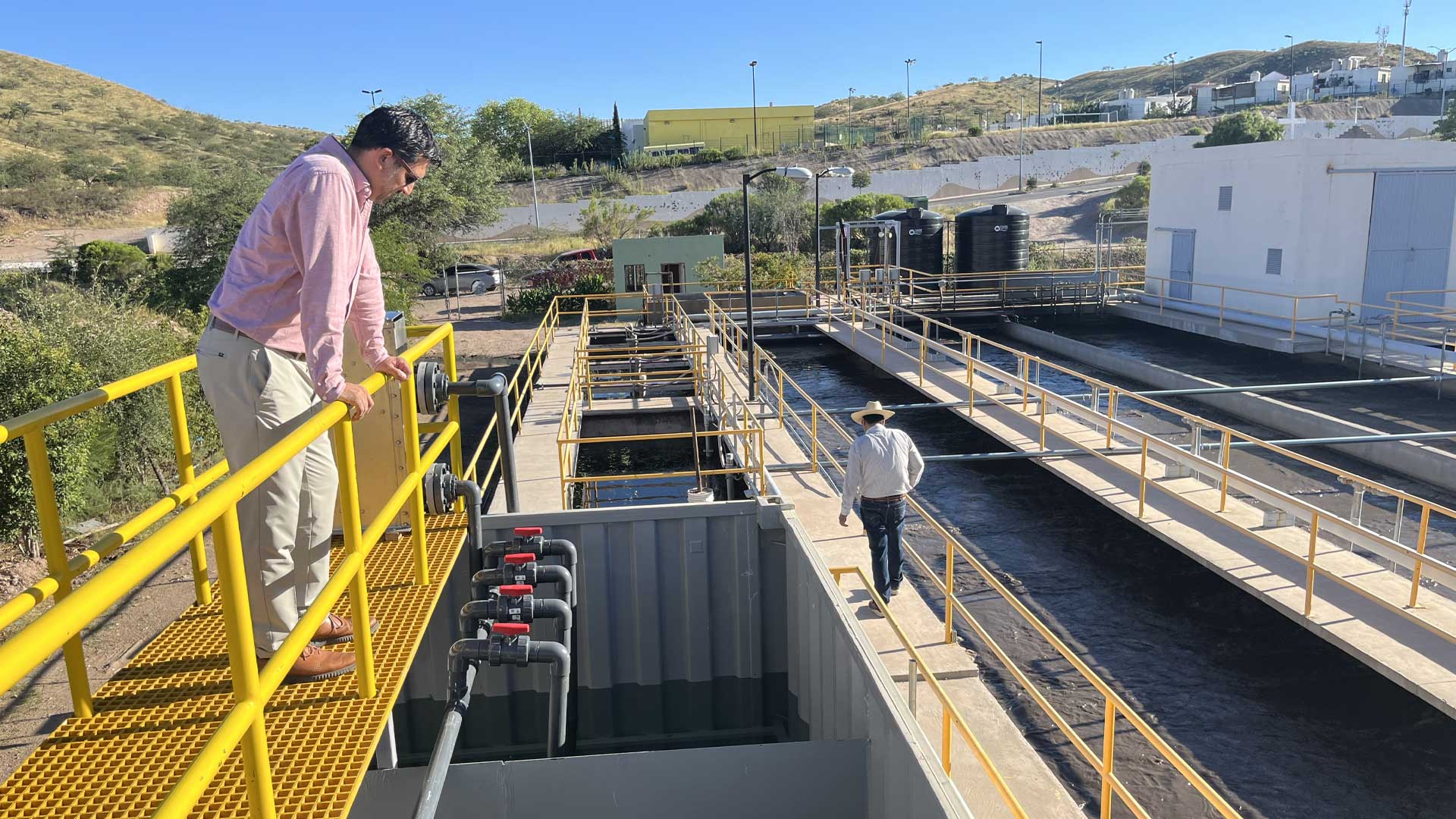
DK: He says he hopes they’re doing enough. The discussion now is about adapting to climate change, because they already know they can’t return to the past temperatures and rain cycles. The more individual people do, the faster and better we are going to adapt collectively. He says this is the message they always convey.
ZZ: After the break, we take those lessons back to the school yard.
[break]
ZZ: This is Tapped, a podcast about water. I'm Zac Ziegler. We now head back to Nogales, Sonora and Danyelle Khmara's story.
(Music fades in)
DK: Profesora Camacho says as part of the school project, they explained to the kids what green infrastructure is, the benefits of a rain garden and how to build one.
GC: Y en un principio — como era algo nuevo, incluso era algo nuevo para mi, ¿no? Era algo nuevo. Yo no conocía sobre esto. Pero conforme fuimos avanzando en las lecciones, y ellos fueron viendo incluso en su casa, en el patio de su casa, ellos podían haber un pequeño jardín…
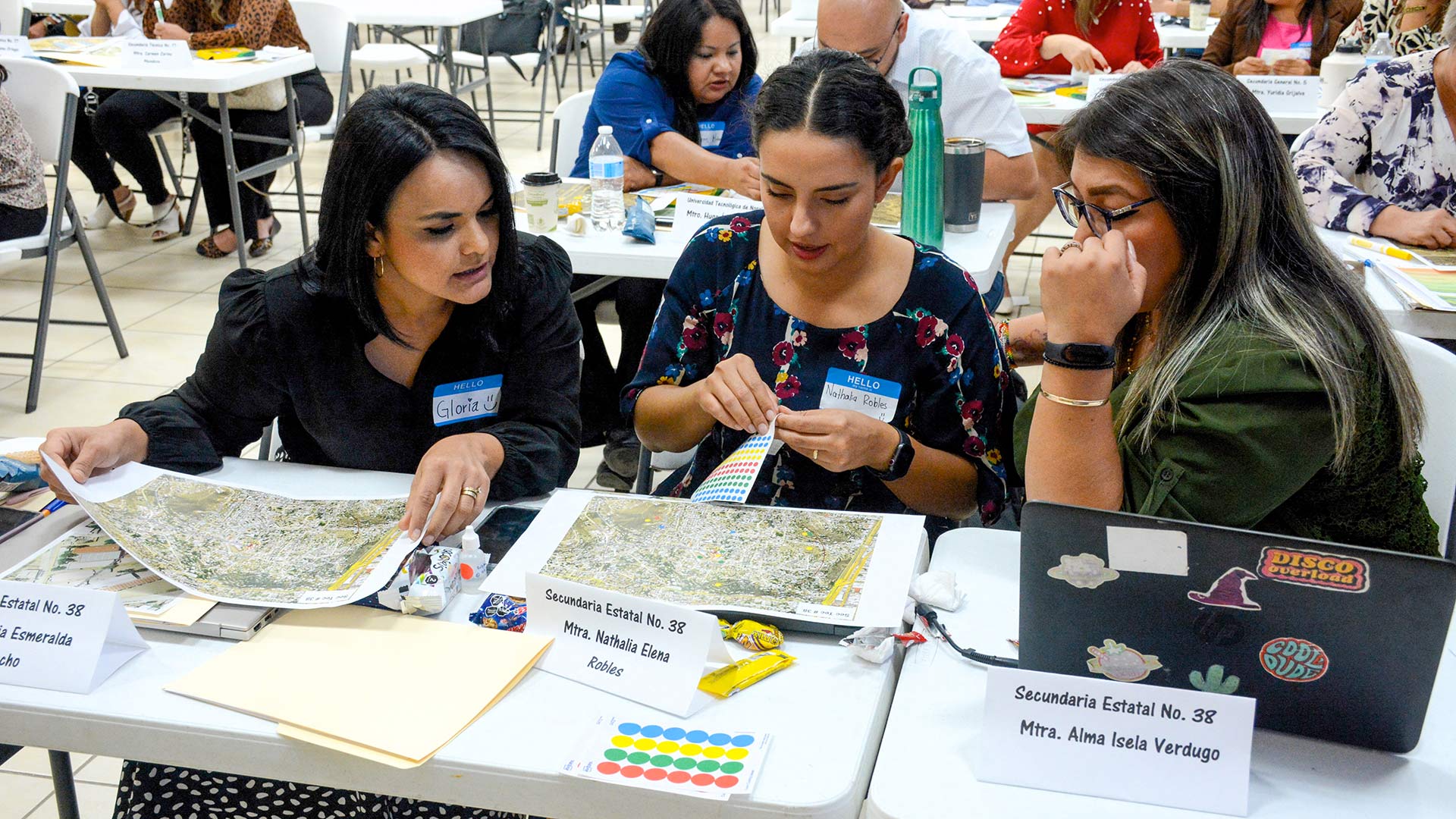 Biology teacher Gloria Camacho and her colleagues learn more about how water harvesting and green infrastructure work to teach their students.
Biology teacher Gloria Camacho and her colleagues learn more about how water harvesting and green infrastructure work to teach their students. DK: She says that green infrastructure and water harvesting was new to her as well as the students. And in the lessons, the kids learned how they could harvest water in their own houses, on their patios they could make little gardens.
GC: … osea cambió su perspectiva porque lo vieron como, ‘ah, entonces, yo puedo ayudar. Yo lo puedo hacer.’ y aunque son pequeños, son adolescentes de 13 años, alrededor. … De cómo poder contribuir en que la lluvia fuera algo bueno. Como poder aprovechar el agua de lluvia. Incluso, les mencionabamos que podían ellos captar agua desde los techos de su casa, direccionarlas de los árboles…
DK: Their perspectives changed as they began to see that they could help. She says even though they’re children — they’re teens, around 13 years old. They began to see how they could help turn the area's heavy rains into a good thing, how to use rainwater. They learned how to capture water from their roofs and direct it toward trees.
They began to see themselves as little architects of sorts.
GC: Entonces, si cambio su perspectiva. Empezaron ellos — hasta se sentían arquitectos, vamos a decir.
(sounds of Danyelle greeting the kids)
GS: Mi nombre es Guadalupe. Todo esto nos puede ayudar mucho con nuestro planeta… de manera en que nos da oxigeno, y les da mucho libertad también a mucho animalitos y vida.
Suheimy Ballesteros: Tenemos que cuidar mucho las plantitas porque no ayudan mucho con el oxígeno y esas cosas. Más que nada, aprendí eso de cuidar más a las plantitas.
Ivanna Moreno Quezada: Eso, como, conectar con la planta, la tierra, cuidarlas y hacer todo ese trabajo.
Francisco Ivan Arbayo Rojas: Ayuda a que los ríos se aumentan un poco, pero aún así sirve para eso.
DK: Bueno, hay algo más que querías decir del proyecto?
FA: Fue incredible.
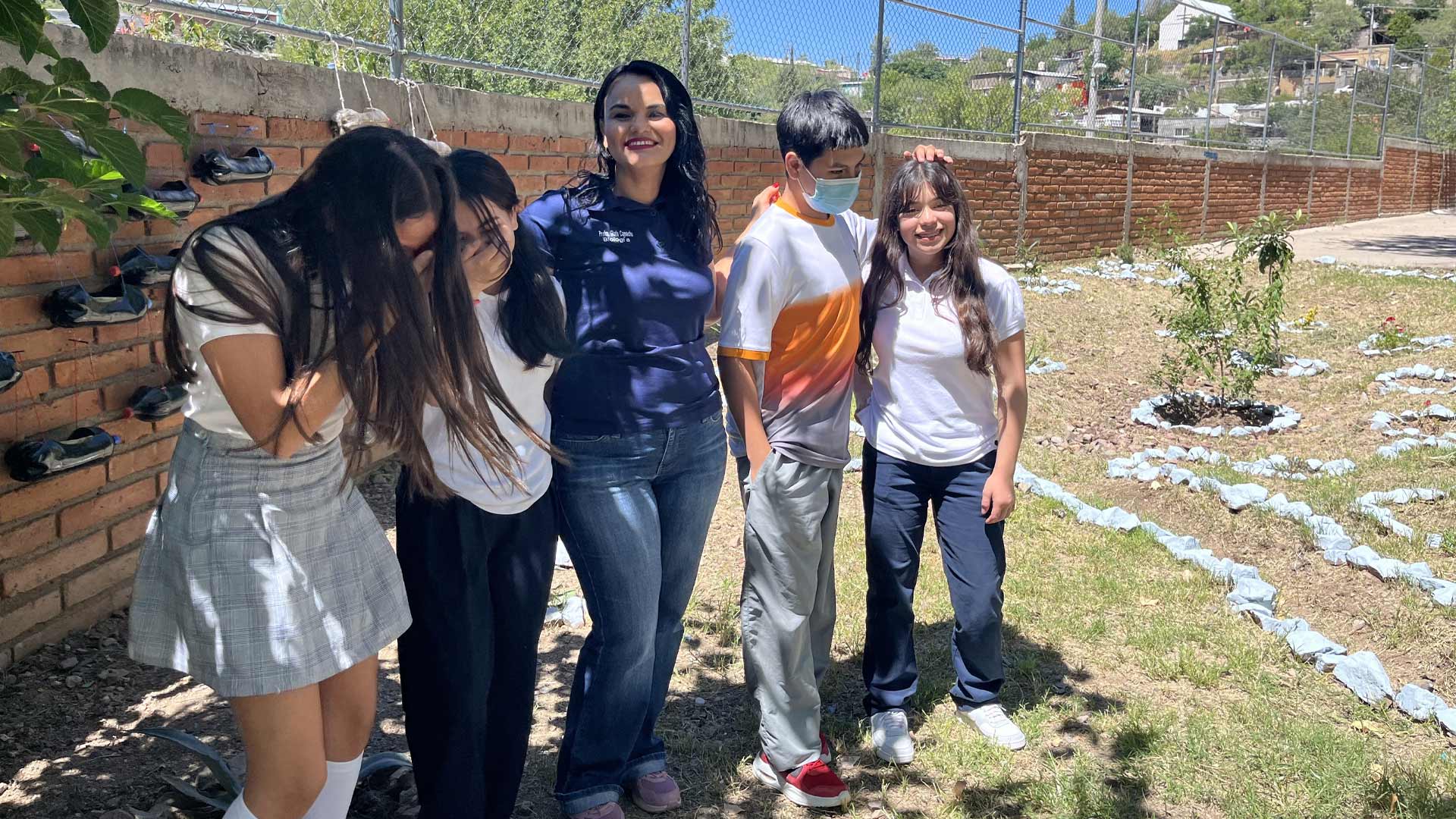
DK: Those were middle school students Guadalupe Silvain Velazquez, Suheimy Ballesteros, Ivanna Moreno Quezada and Francisco Ivan Arbayo Rojas talking about what they learned from the project: that rain gardens and taking care of the plants helps the planet and animals and maintaining clean oxygen. That rain can replenish the water supply. And that they can work together to protect the environment.
They are all 14 except Ivanna, who will be 14 in December.
(Music)
DK: I ask Gloria if she thinks that her students will bring what they’ve learned about green infrastructure and water harvesting home and teach it to their parents.
GC: Yo pienso que sí. Bueno, es como en cualquier lugar. Hay personas que lo hacen. Hay personas que no. Pero por lo pronto, yo siento que ya pusimos un granito de arena. Ya contribuimos un poquito de, y los chicos, los estudiantes ya no pueden decir, ‘yo no sé.’ Ya lo llevan pues. Y hay niños que si, sienten esa necesidad como de hacer más por el ambiente pues. Hay niños que son conscientes. No todos lo son. Claro, verdad.
DK: She says that she thinks they will. Sure, like with anything, some will and some won’t. But they’ve done an important thing by giving the children this information. And there are children who feel the need to do more for the environment.
GC: Pero yo pienso que si va a marcar una diferencia si esto se continúa. Osea si no es nada más como que, ‘hay ya lo hicimos el año pasado. Ya no lo vamos a hacer.’ Yo considero que es necesario que cada año a todas las generaciones que vengan se les esté partiendo esta información para que ellos conozca, porque es muy bonito ver los resultados y ver cómo se interesan. Que ellos se sientan los tomas en cuenta.
DK: If the work continues, it will make a difference. Gloria thinks it’s important that they do this project every year with all future generations so that they understand the importance of green infrastructure, green space and water harvesting. And the children were empowered by being taken into account on this important issue.
Javier, working on urban planning for Nogales, helped with this project and trained the teachers.
JV: Les enseñé a los maestros y le dije a los maestros que dijeron a sus alumnos que aqui … A veces dejan unos patios muy chiquitos atrás de la casa, patio posterior, que son a veces de tres por tres metros. En cuánto le va bien a la familia, lo primero que hacen es echar concreto, poner una coladera, y mandar al drenaje el agua provial. Entonces eso nos hace problemas sanitarios porque se satura el drenaje y el drenaje empieza salir por las calles, corre por las calles, se vuelve un tema ya de toda la sociedad.
DK: In Nogales, it’s common that houses have small backyards, about three-by-three meters. When a family starts doing well, the first thing they do is pour concrete in the yard and put in a drain that sends the water that pools on the concrete out into the street, which can cause health risks, carry trash into the streets and the water supply, and becomes an issue for the entire area.
JV: Entonces eso es lo que yo capacite, como podemos en nuestra casa quitar ese concreto o no echarlo o hacer un jardín, captar el agua allí, no la metas al drenaje, captas un poquito de agua de la que va a los arroyos y causa tantas muertes y arrastra basura, no echar el basura al arroyo, en eso capacite yo a los maestros. Y le pedí que decían con sus alumnos.
DK: Javier told the teachers to talk to their students about how they can remove that concrete or not pour it in the first place, how to make a garden and capture the water there. And that way, they are retaining a little bit of the water that floods the streets and causes so many problems and deaths.
Researchers with the project estimated that in the schools’ rain gardens they were retaining 7% of the water that the schools produced — all the water that runs off the roofs and solid surfaces and isn’t absorbed into the ground. I asked Javier about the significance of what I assumed was a small portion.
JV: Cualquier logro yo lo aplaudo. Cualquier logro yo lo aplaudo porque así es como vamos a mejorar y cambiar esa mentalidad y premiar a los que sí lo están haciendo. Y si una persona te habla horita de un metro por un metro, si con ese metro por metro, captan el 2 por ciento, que bueno, pero si lo replican cada casa, cuántos en litros. A lo mejor en porcentaje, suele poquito, pero vamos viendo en litros, y ya vamos generando una cantidad mucho mayor.
DK: Javier says he applauds the achievement and will applaud any such achievement, no matter how small, because that is how to change mindsets and reward those who are making a difference. And even if people were capturing 2% of their water and that was replicated in each household, that would add up to a much larger amount.
JV: No es suficiente porque son muy poquitas, osea hablando ya globalmente fueron siete nada más jardines de lluvia en sietes escuelas. Obviamente no se va a ver. No lo vamos a ver, pero si lo vamos replicando cada vez y nosotros como gobierno lo hacemos en esas áreas, como te mostré, vamos a ir haciendo la diferencia, cada vez mejor y cada vez ir mejorando. Eso es lo que yo creo que …
DK: He says that in the bigger picture, of course seven rain gardens in seven schools won’t make a notable difference, but if that is replicated, and if the government works on projects like what they’re beginning in Nogales, it will make a difference, over time it will get better and better. And he won’t minimize any effort toward that — on the contrary, he applauds it and holds it up as an example for others.
JV: … cualquier esfuerzo nunca lo voy a minimizar. Si no al contrario. Aplaudirlo e incentivar y ponerlo de ejemplo y que más gente lo haga.
DK: Javier says we all need to enhance our environmental knowledge. And he is learning himself. He says, the truth is that we never stop learning, and what we know now can change. Maybe we will look back and see we got something wrong, but we have to start. We have to start working on it.
(Fade in sounds of the school)
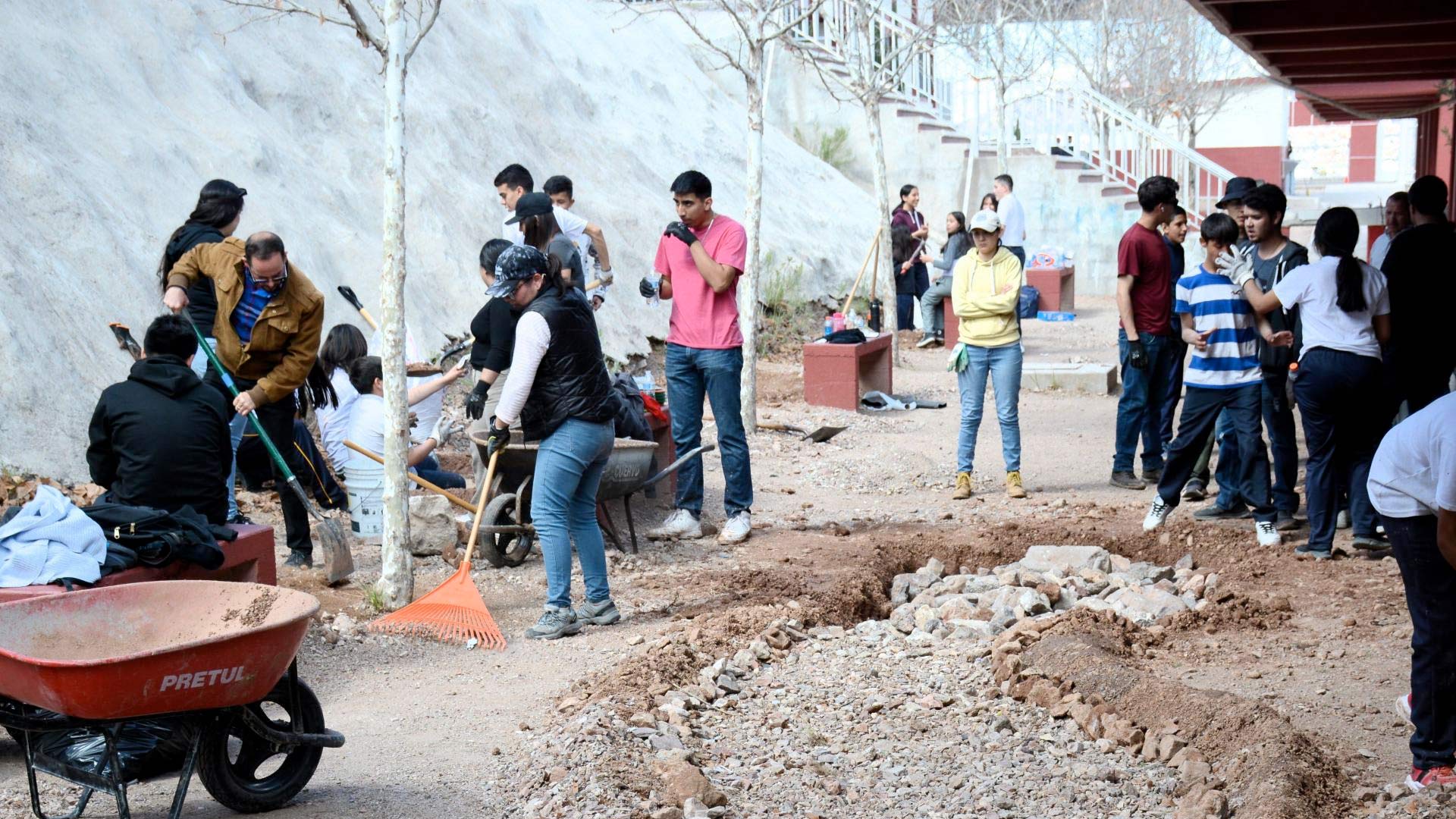
ZZ: While Nogales, Sonora is working to solve its water problems, contamination may only be getting worse for people in Arizona's northernmost reaches, a place we visited at the end of last season, where a uranium mine that sat dormant for almost 40 years is now back in production. And that has tribal members and activists worried about what will happen to water in the area. So, we head back to the Havasupai Nation and find out what's happened in the last year.
That's next time.
Tapped is a production of AZPM News.
This episode was written, reported and mixed by Danyelle Khmara, with additional mixing and editing by me, Zac Ziegler.
Christopher Conover is our news director.
Our theme music and some interstitial music is by Michael Greenwald.
Visit our website in the podcast section of AZPM.org for pictures links and more.
Thanks for listening.
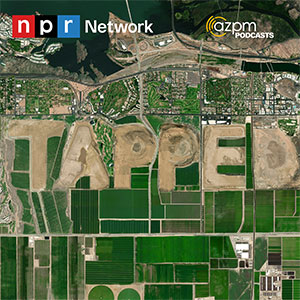





By submitting your comments, you hereby give AZPM the right to post your comments and potentially use them in any other form of media operated by this institution.